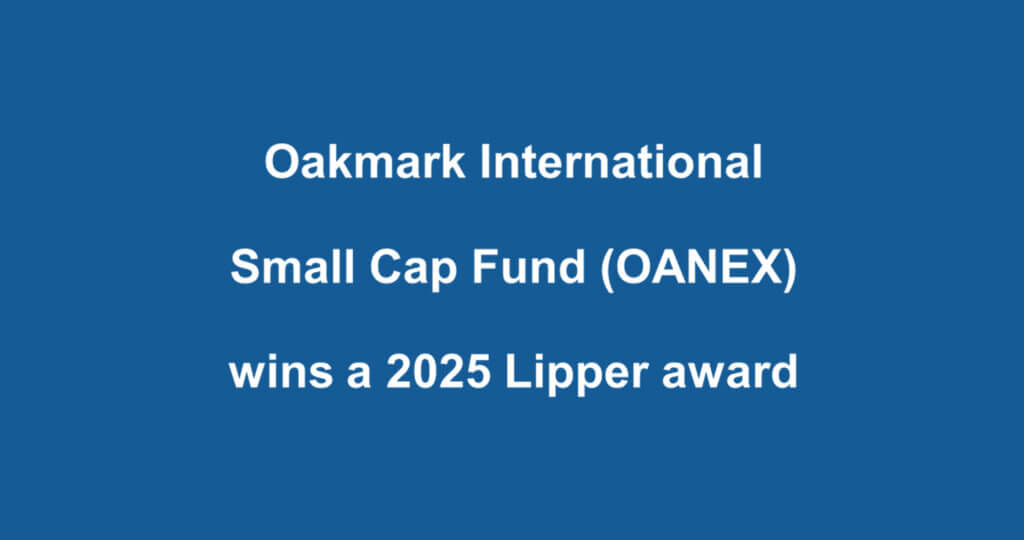Oakmark International Fund – Investor Class
Average Annual Total Returns 09/30/21
Since Inception 09/30/92 9.28%
10-year 9.02%
5-year 8.27%
1-year 41.96%
3-month -5.02%
Gross Expense Ratio: 1.06%
Net Expense Ratio: 1.04%
Oakmark International Small Cap Fund – Investor Class
Average Annual Total Returns 09/30/21
Since Inception 11/01/95 9.33%
10-year 9.31%
5-year 9.77%
1-year 48.51%
3-month -1.82%
Gross Expense Ratio: 1.39%
Net Expense Ratio: 1.37%
Expense ratios are based on estimated amounts for the current fiscal year; actual expenses may vary.
The net expense ratio reflects a contractual advisory fee waiver agreement through January 27, 2022.
Past performance is no guarantee of future results. The performance data quoted represents past performance. Current performance may be lower or higher than the performance data quoted. The investment return and principal value vary so that an investor’s shares when redeemed may be worth more or less than the original cost. The To obtain the most recent month-end performance data, view it here.
Fellow Shareholders,
After five consecutive quarters of strong performance for both of our international funds, the Oakmark International and International Small Cap Funds have taken breathers with the International Fund declining 5.0% for the quarter and the International Small Cap Fund dropping 1.8%. In addition to the negative absolute performances, both Funds lost ground to their respective benchmarks (please see separate letter for each of the Funds). Despite this short-term downturn, we are pleased with each of these portfolios and continue to believe they offer substantial value.
The Return of the Pandemic Trade
The overall hindrance to the performance of value funds in general, and with Oakmark specifically, is the return of the “pandemic trade.” Due to the more contagious Delta variant, a new wave of Covid-19 cases triggered a slowdown in economic reopenings around the world. In addition, some areas, particularly Asia and Australia, implemented new economic restrictions and lockdowns. This has caused a weakness in the share prices of economically sensitive businesses as investors flocked to those that are less so. However, as we have seen in the past, individual economic reopenings cause dramatic growth spikes in these reopened areas on account of pent-up demand. A result of this is the post-lockdown spending sprees fueled by high savings rates. However, global supply chains haven’t been able to handle these reopenings due to the explosive growth. Therefore, shortages have developed across the economic spectrum from semiconductors to labor. This, in essence, will extend the economic recovery as the demand is unable to be satisfied, which means more future spending. As such, especially given the low valuations of the economically sensitive businesses we own, we believe our exposure in these areas is appropriate. Ultimately, the combination of low valuations and a lengthened economic recovery should have a positive impact on earnings and cash flows and, thus, share prices.
Too Many Dollars Chasing Too Few Goods
Structural inflation is mainly a monetary phenomenon caused by a monetary policy that excessively expands the supply of money. In layman’s terms, if the supply of money increases faster than its velocity, it impacts the price level and economic output. During the Global Financial Crisis (GFC), money supply exploded globally and central banks acted again to swiftly relax during the pandemic. Thankfully, inflation continued to be restrained as the velocity of money during this period decreased, preventing inflation—a result of post-GFC massive reserve building (and other reasons) by financial institutions around the globe. In fact, for almost three decades, inflation has remained subdued as the Federal Reserve, the central bank of the United States, aggressively eliminated inflation in the 1980s by instituting a very tight monetary policy. Now, as prices rise globally, the question persists—is this inflation structural or cyclical? Though at this stage it is too early to formulate a firm conclusion, given the huge amount of growth in money supply we have seen around the world, one cannot exclude the possibility that some of this is structural, which means that eventually central banks will have to tighten. I mention this because of our heavy exposure to financials, which could, all else being equal, be huge beneficiaries of a higher rate environment. Even though most of our investments have been able to grow earnings, this growth has been muted by “lower for longer” interest rates, particularly in Europe. Today these holding are still selling at low valuations with high dividend yields and capital positions. Any hint of firmer rates could be advantageous for these holdings.
Again, we are appreciative of your continued support, especially given the previous three months’ “soft” returns. Rest assured, we will continue to work hard to ensure that we can deliver the best investment results possible.
Portfolio holdings are subject to change without notice and are not intended as recommendations of individual stocks.
The funds’ portfolios tend to be invested in a relatively small number of stocks. As a result, the appreciation or depreciation of any one security held by the Fund will have a greater impact on the Funds’ net asset value than it would if the Fund invested in a larger number of securities. Although that strategy has the potential to generate attractive returns over time, it also increases the Funds’ volatility.
The stocks of smaller companies often involve more risk than the stocks of larger companies. Stocks of small companies tend to be more volatile and have a smaller public market than stocks of larger companies. Small companies may have a shorter history of operations than larger companies, may not have as great an ability to raise additional capital and may have a less diversified product line, making them more susceptible to market pressure.
Investing in foreign securities presents risks that in some ways may be greater than U.S. investments. Those risks include: currency fluctuation; different regulation, accounting standards, trading practices and levels of available information; generally higher transaction costs; and political risks.
The information, data, analyses, and opinions presented herein (including current investment themes, the portfolio managers’ research and investment process, and portfolio characteristics) are for informational purposes only and represent the investments and views of the portfolio managers and Harris Associates L.P. as of the date written and are subject to change and may change based on market and other conditions and without notice. This content is not a recommendation of or an offer to buy or sell a security and is not warranted to be correct, complete or accurate.
Certain comments herein are based on current expectations and are considered “forward-looking statements”. These forward looking statements reflect assumptions and analyses made by the portfolio managers and Harris Associates L.P. based on their experience and perception of historical trends, current conditions, expected future developments, and other factors they believe are relevant. Actual future results are subject to a number of investment and other risks and may prove to be different from expectations. Readers are cautioned not to place undue reliance on the forward-looking statements.
All information provided is as of 09/30/2021 unless otherwise specified.







